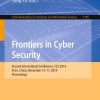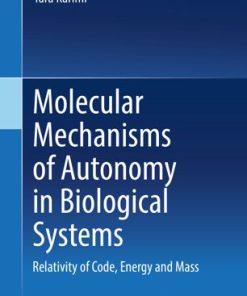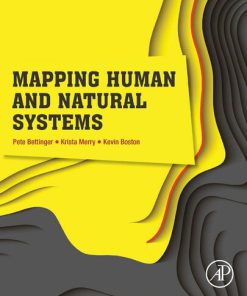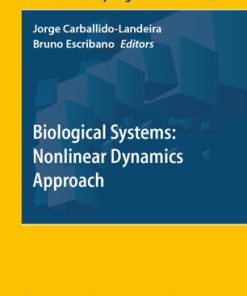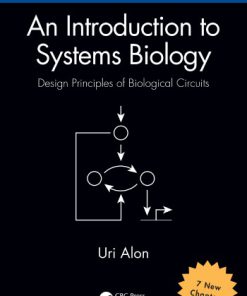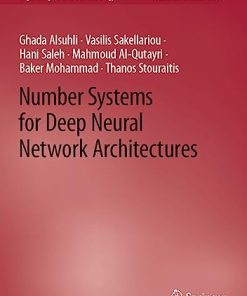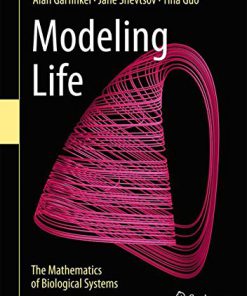Mapping Biological Systems to Network Systems 1st Edition by Heena Rathore 3319297828 9783319297828
$50.00 Original price was: $50.00.$25.00Current price is: $25.00.
Mapping Biological Systems to Network Systems 1st Edition by Heena Rathore – Ebook PDF Instant Download/DeliveryISBN: 3319297828, 9783319297828
Full download Mapping Biological Systems to Network Systems 1st Edition after payment.
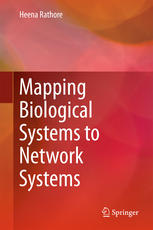
Product details:
ISBN-10 : 3319297828
ISBN-13 : 9783319297828
Author: Heena Rathore
The book presents the challenges inherent in the paradigm shift of network systems from static to highly dynamic distributed systems – it proposes solutions that the symbiotic nature of biological systems can provide into altering networking systems to adapt to these changes. The author discuss how biological systems – which have the inherent capabilities of evolving, self-organizing, self-repairing and flourishing with time – are inspiring researchers to take opportunities from the biology domain and map them with the problems faced in network domain. The book revolves around the central idea of bio-inspired systems — it begins by exploring why biology and computer network research are such a natural match. This is followed by presenting a broad overview of biologically inspired research in network systems — it is classified by the biological field that inspired each topic and by the area of networking in which that topic lies. Each case elucidates how biological concepts have been most successfully applied in various domains. Nevertheless, it also presents a case study discussing the security aspects of wireless sensor networks and how biological solution stand out in comparison to optimized solutions. Furthermore, it also discusses novel biological solutions for solving problems in diverse engineering domains such as mechanical, electrical, civil, aerospace, energy and agriculture. The readers will not only get proper understanding of the bio inspired systems but also better insight for developing novel bio inspired solutions.
Mapping Biological Systems to Network Systems 1st Table of contents:
1 Introduction: Bio-inspired Systems
Abstract
1.1 Biological Systems
1.2 Network Systems
1.3 Mapping Biological Systems to Network Systems
1.4 Motivation
1.5 Organization of Book
References
2 Computer Networks
Abstract
2.1 Introduction
2.2 Network Topologies, Types, and Design Strategies
2.2.1 Network Topologies
2.2.2 Network Types
2.2.3 Design Strategies for Communications
2.3 Wireless Networking
2.4 Usage of Networking
2.5 Challenges and Issues of Networking
2.5.1 Quality of Service
2.5.2 Connectivity, Manageability, and Scalability
2.5.3 Network Security
2.5.4 Network Congestion
2.6 Future of Networking
2.7 Summary
References
3 Inceptive Findings
Abstract
3.1 Introduction
3.2 Structural Composition
3.3 Highly Optimized Tolerance (HOT) Model
3.4 Biological Evolution
3.5 Natural Computing
3.6 Feedback Loops for Kidney-Blood Pressure
3.7 Summary
References
4 Swarm Intelligence and Social Insects
Abstract
4.1 Ant Colony Optimization
4.2 Bird Colony Optimization
4.3 Bee Colony Optimization
4.4 Firefly Synchronization
4.5 Bacterial Foraging Optimization
4.6 Cuckoo Search
4.7 Other Inspirations
4.8 Summary
References
5 Immunology and Immune System
Abstract
5.1 Human Immune System
5.2 Primary Versus Secondary Response
5.3 Artificial Immune Systems
5.3.1 Negative Selection
5.3.2 Clonal Selection
5.3.3 Artificial Immune Systems
5.3.4 Pattern Recognition
5.4 Summary
References
6 Information Epidemics and Social Networking
Abstract
6.1 Epidemic Spreading
6.2 A System for Building Immunity in Social Networks
6.3 Bio-inspired Solutions for Social Networks
6.4 Summary
References
7 Artificial Neural Network
Abstract
7.1 Introduction
7.2 Biological Neural Network
7.3 Artificial Neural Network
7.3.1 Learning Rules in ANN
7.3.1.1 Error Correction Rules
7.3.1.2 Boltzmann Learning Rule
7.3.1.3 Hebbian Rule
7.3.1.4 Competitive Learning Rule
7.3.2 Types of ANN
7.3.2.1 Single Layer and Multilayer Perceptron
7.3.2.2 Radial Basis Function Networks
7.3.2.3 Competitive Networks
7.3.2.4 Kohonen’s Self-organizing Maps
7.3.2.5 Hopfield Network
7.3.2.6 Adaptive Resonance Theory Model
7.4 Applications of Artificial Neural Networks
7.4.1 Pattern Classification
7.4.2 Clustering
7.4.3 Optimization
7.4.4 Prediction and Forecasting
7.5 Summary
References
8 Genetic Algorithms
Abstract
8.1 Introduction
8.2 Genetic Algorithms
8.3 Encoding
8.4 Genetic Algorithm Operators
8.4.1 Selection
8.4.2 Crossover
8.4.3 Mutation
8.5 Applications of Genetic Algorithms
8.6 Summary
References
9 Bio-inspired Software-Defined Networking
Abstract
9.1 Software-Defined Networking
9.2 Wireless Software-Defined Networking
9.3 Security in Software-Defined Networking
9.4 Bio-inspired Solutions for Software-Defined Networking
9.4.1 Self-organization and Stability in Software-Defined Networks
9.4.2 Fault Management in Software-Defined Networking
9.4.3 Cognition: A Tool for Reinforcing Security in Software-Defined Network
9.4.4 Control Loops for Autonomic Systems
9.4.5 Self-governance and Self-organization in Autonomic Networks
9.5 Summary
References
10 Case Study: A Review of Security Challenges, Attacks and Trust and Reputation Models in Wireless
Abstract
10.1 Introduction
10.2 Constraints on Wireless Sensor Networks
10.3 Threat Model
10.4 Security Requirements for Wireless Sensor Networks
10.5 Focus and Contents
10.6 Attacks in Wireless Sensor Networks
10.6.1 Attacks on Data
10.6.2 Attacks on Infrastructure
10.7 Key Management in Wireless Sensor Networks
10.8 Trust and Reputation Model
10.8.1 Methods to Calculate Trust
10.8.2 Methodologies to Model Trust
10.8.3 Comparative Analysis
10.9 Bio-inspired Security Model for Wireless Sensor Networks
10.9.1 Machine Learning Model
10.9.2 Immune Model
10.9.3 Experiments and Results
10.10 Intelligent Water Drops
10.10.1 IWD in Wireless Sensor Networks
10.10.2 Algorithm
10.11 Summary
References
11 Bio-inspired Approaches in Various Engineering Domain
Abstract
11.1 Bio-inspired Energy Systems
11.1.1 Bio-inspired Solar Energy Program at CIFAR (Canadian Institute for Advance Research)
11.1.2 Bio-inspired Optimization of Sustainable Energy Systems
11.1.3 Biomimicry Innovations for Energy Sustainability
11.1.4 Bio-inspired Artificial Light-Harvesting Antennas for Enhancement of Solar Energy
11.2 Bio-inspired Agriculture Systems
11.2.1 CO–CH Project
11.2.2 Bio-inspired Sensing for Agriculture Robots
11.2.3 Bio-inspired Special Wettability
11.2.4 Biorefinery: A Bio-inspired Process to Bulk Chemicals
11.3 Bio-inspired Aerospace Systems
11.3.1 Biomorphic Explorers
11.3.2 Bio-inspired Design of Aerospace Composite Joints for Improved Damage Tolerance
11.3.3 Pneumatic Artificial Muscles
11.4 Bio-inspired Electrical Systems
11.4.1 Biologically Inspired Electrically Small Antenna Arrays with Enhanced Directional Sensitivity
11.4.2 Biologically Inspired At-scale Robotic Insect
11.4.3 Biomimetic and Bio-inspired Robotics in Electric Fish Research
11.4.4 Future Power Grid Inspired from Brain
11.5 Bio-inspired Mechatronics Systems
11.5.1 Bio-inspired Mechatronics
11.5.2 Bio-inspired Actuation
11.5.3 Bio-inspired Control
11.5.4 Future of Bio-inspired Mechatronics
11.6 Bio-inspired Civil Engineering
11.6.1 Corrosion Protection via Application of Bacteria and Bio-polymers
11.6.2 Nondestructive Evaluation of Civil Infrastructures
11.6.3 Designing Model Systems for Enhanced Adhesion
11.6.4 Artificial Neural Networks in Urban Runoff Forecast
11.7 Future: Bio-inspired Computation
People also search for Mapping Biological Systems to Network Systems 1st:
systems within systems examples
what is system mapping
system mapping techniques
biological mapping
systems biology network
Tags: Mapping, Biological Systems, Network Systems, Heena Rathore
You may also like…
Science (General)
Molecular Mechanisms of Autonomy in Biological Systems Tara Karimi
Science (General)
Mapping Human and Natural Systems 1st Edition Pete Bettinger
Biology and other natural sciences - Human Biology
Human Biological Aging: From Macromolecules to Organ Systems 1st Edition Glenda E. Bilder
Uncategorized
Mathematics - Applied Mathematics
Number Systems for Deep Neural Network Architectures 1st Edition Alsuhli



